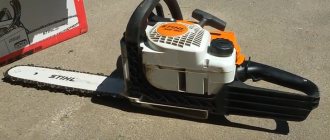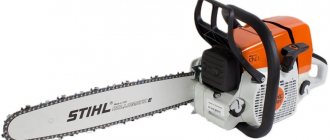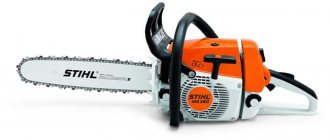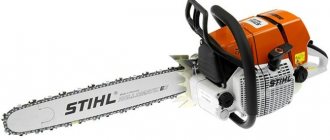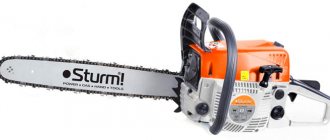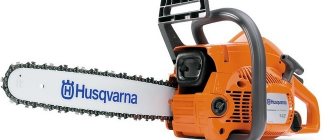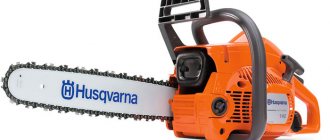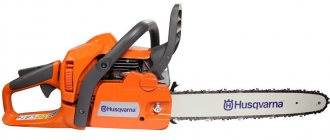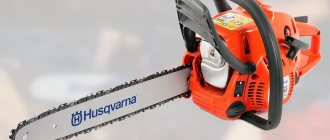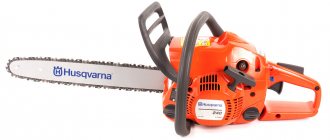Adjusting the chainsaw carburetor
Most chainsaws have three adjustment screws on the carburetor. In order about each:
- T - Idle screw. The idle screw is responsible for the position of the throttle valve when the throttle handle is completely released. If the throttle valve is not open enough, the engine will stall when the handle is released because the throttle valve will cut off the supply of the fuel mixture. If the throttle valve is opened more than it should be, then the chain will rotate, which is strictly prohibited by safety precautions when working with a chainsaw.
- L-Low speed adjustment screw. This screw regulates the amount of fuel in the fuel mixture when the chainsaw is idling. If the amount of fuel is large, the engine will stall under load; if there is not enough fuel, the result will be engine overheating, scuffing, and so on...
- H-High speed adjustment screw. Responsible for the amount of fuel in the mixture when the chainsaw is operating. If this adjustment is set to a larger amount of fuel, then the engine runs “unacceptably” and smokes, and if it is set to a smaller amount, then we get too high speeds and overheating.
Carburetor adjustment step by step
- Check the condition of the air filter. We remove it and either clean it or change it. If the air filter is clogged with dirt and sawdust, the chainsaw will not operate normally.
- We check the condition of the muffler. It must be clean and unclogged. Read more about cleaning the muffler HERE.
- Before you start adjusting the carburetor, you should fill the fuel tank at least halfway.
- If the chainsaw is able to start, then you should let it run for a few minutes to warm up. If the adjustment is carried out “cold”, then the mixture will be over-rich after warming up.
- You need to start adjusting by adjusting the idle speed - screw L. It is highly advisable to have a tachometer, then we focus on 2700 rpm. If not, then we need to find the highest idle speed. In this case, the chain should not rotate!!! If it still spins (the chain, of course, and not the Earth), then we stop it by rotating screw T. The sound of the chainsaw should be like when listening to the file below. https://benzopilatut.ru/wp-content/uploads/2016/01 /chainsaw-idling.wav
- We regulate high revolutions - screw H. If we rotate it clockwise, the revolutions will increase, and if counterclockwise, they will fall. We tighten it until failures appear in the ignition. After that, turn it out about one-fifth of a turn. The sound of a chainsaw when operating at maximum speed should be like this when listening to the file below. https://benzopilatut.ru/wp-content/uploads/2016/01/Chainsaw-maximum-speed.wav
- Let's check how the chainsaw is gaining momentum. She should type them smoothly and quickly. If the speed increases slowly, then turn out screw L slightly.
Remember that the optimal carburetor adjustment is:
- The maximum possible life of a chainsaw
- Optimal fuel consumption
- Good performance
Basic faults
A gasoline saw has a complex design. The engine, carburetor, clutch and starter all experience serious stress during operation and break down over time. But there are malfunctions that happen much more often than others, and we’ll talk about them further.
Makita DCS34 35 won't start
This is one of the most common situations that happens, but not always due to a malfunction.
If for some reason the Makita DCS34 35 chainsaw does not start, the first thing you need to start is to check the presence of fuel in the tank, and also make sure that the fuel filter is functioning properly. Next, you need to make sure that the chainsaw startup algorithm is followed.
If these points are fulfilled, but the chainsaw still shows no signs of life, then you must proceed according to the following algorithm:
- Unscrew the spark plug and check for the presence of a spark; to do this, with the ignition on, install the spark plug in the cap of the high-voltage wire and attach it to the cylinder, then pull the starter several times.
- Plug the spark plug hole with your finger and pull the starter several times (air from the engine should break through under your finger, making a characteristic sound), this way you can check the compression. If it is not there, the saw will not start and will need major repairs.
- Using a medical syringe (this is more convenient), pour about 5 ml of fuel directly into the spark plug hole and try to start the Makita. If the chainsaw starts, then the problem is in the carburetor or the crankshaft seals are faulty. They can seriously poison the air and for this reason the fuel pump will fail.
- If all the previous methods did not help determine the malfunction, then there is a possibility that the spark plug is flooded. To find out, we do the following. We screw the spark plug into place and try to start the chainsaw, then unscrew it and inspect it. A wet spark plug and a large amount of fuel in the cylinder (the saw must be turned over to check the fuel in the cylinder) confirms an overflow.
The candle is flooded
This is one of the most common malfunctions, which can have several causes. The first is a malfunction of the carburetor or its incorrect adjustment. To eliminate this, it is necessary to adjust the fuel quality and quantity screws that are on the carburetor. Read about how to do this here.
The second is that the air filter is dirty, as a result of which the engine does not have enough air and the spark plug floods. In such a situation, there is one caveat: during the first cold start, the saw should start and immediately stall, and upon further attempts to start it will not start. We also recommend reading an article that explains in detail why the candle is flooded and what to do.
Replacing the sprocket
The most common mechanical malfunctions of the Makita DCS34 chainsaw include critical wear of the drive sprocket or chainsaw tire. The problem can be solved by replacing the parts with new ones. The sprocket is easily removed, since it is secured to the shaft with a washer and a stopper.
To remove it, you need to unscrew the side cover and remove the bar and chain. Next, remove the stopper from the shaft, then the washer, and after it, remove the sprocket connected to the clutch drum.
Everything is assembled in reverse order.
Makita DCS4610 chainsaw device
The design of the Makita DCS4610 branded chainsaw is distinguished by its high density and stability. The internal parts and working mechanisms of the model are placed as close to each other as possible. At the same time, they do not contact each other, which eliminates the risk of friction and overheating of individual elements.
The factory design of the Makita DCS4610 chainsaw is based on a 2-stroke power unit running on a mixture of 92-octane gasoline and synthetic motor oil. The engine consists of an all-metal non-separable crankshaft, a forged piston with one standard and one additional ring, and a chrome-plated factory cylinder with a displacement of 45.1 cm3. The improved layout of the Makita DCS4610 model reduces the specific fuel consumption of the engine - it is 580 g/kW/hour when the internal combustion engine is operating under maximum loads.
The standard design of the Makita DCS4610 chainsaw includes a Zama brand diaphragm carburetor. It is equipped with an enlarged float chamber and a high-performance diffuser that forcibly draws in air to continuously enrich the fuel mixture. The dismountable design of the fuel unit simplifies its washing and self-repair.
The Makita DCS4610 branded chainsaw is equipped with a Phelon ignition system. The assembly includes a durable factory coil equipped with a primary and secondary high-voltage winding, as well as an NGK BPMR 7A spark plug. The combined operation of the ignition system ensures timely ignition of the fuel so that the chainsaw can be started smoothly in any weather. The manufacturer has provided keyless access to the saw's spark plug - this allows the operator to replace it with his own hands.
For the safety of the operator and others during operation of the chainsaw, it is equipped with a mechanical jet brake and a chain catcher. These elements are responsible for the timely stop of the cutting element in the event of its contact with a solid object or breakage.
The internal parts of the Makita DCS4610 chainsaw are housed in a durable plastic case that is highly resistant to heat, vibration and shock. The body is equipped with ergonomic handles covered with high-quality anti-slip material.
General provisions
Before moving on to the review of specific samples, let’s get acquainted with the design features and main advantages of chainsaws of this Japanese brand:
Design features
The design of the Makita chainsaw is not particularly complicated
In the design of the instrument under consideration, a number of the following most important elements can be distinguished:
Piston. This is the heart of the chainsaw, its propulsion system, which converts incoming gasoline into kinetic energy, which causes the chain to rotate.
The price of a cylinder with piston and rings is approximately two-thirds of the cost of the entire tool
Carburetor channels can often become clogged due to the use of low-quality gasoline and oil.
Domestic models have a smaller gas tank than professional ones
Ignition. Generates electric current when the tool is started;
If the saw does not start, then first of all you should check the ignition coil.
Oil tank. Contains oil, which is supplied to the chain during operation of the tool.
Advantages
Simple operating instructions. Any home craftsman can easily master the use of a household model;
Using a Makita chainsaw with your own hands is easy and convenient
- Excellent performance;
- Availability of inertial chain brake;
- Excellent build quality;
- Ergonomics;
- High anti-vibration protection;
- Long service life;
- A wide range of models, which we will look at in more detail below.
Technical characteristics of the drive and clutch
Makita DCS4610-36/40, with its own weight of 4.75 kg, differs from similar models in its compact dimensions, which has a positive effect on its functionality and versatility of use.
The tool is equipped with a simple design and durable two-stroke air-cooled carburetor internal combustion engine. Power unit with a displacement of 45.1 cm3 and a power of 2.3 hp. It runs on a fuel mixture made from high-octane gasoline and semi-synthetic motor oil for two-stroke engines.
Fuel enters the Zama carburetor from a 370 ml reservoir located in the body. The engine is equipped with a manual starter with an easy start system, a boost pump, a Phelon electronic ignition system, an effective vibration damper, a joystick control circuit for starting and operating the power unit.
| Model | Makita DCS4610-36/40 |
| Manufacturer | Makita |
| Production (assembly) | Germany |
| Homeland of the brand | Japan |
| Saw class | Household |
| Power, hp (kW) | 2,3 (1,7) |
| Engine volume, cm3 | 45,1 |
| Chain pitch, inches | 3/8 |
| Chain thickness, mm | 1,3 |
| Fuel tank volume, l | 0,37 |
| Oil tank volume, l | 0,25 |
| Tire length, cm (inches) | 35/40 (14/16) |
| Noise level, dB(A) | 101 |
| Warranty, years | 1 |
| Weight, kg | 4,75 |
| Instructions | Download |
Headset
The powerful drive allows you to take advantage of the performance advantages of removable equipment, which includes a productive 16-inch bar and a proprietary wear-resistant saw chain with a standard 3/8-inch pitch.
- Setting the optimal chain tension is carried out by a screw mechanism, cooling and lubrication is achieved by automatically supplying the oil recommended in the instructions to the working area from an internal reservoir with a volume of 250 ml.
- If a traumatic or other unusual situation occurs, the chain is blocked using the emergency brake. The movement of the chain is blocked by the Safety Matic system, with the safety barrier moving slightly forward in almost a split second.
- The design of the headset includes a chain catcher, which prevents the operator from getting injured if it breaks. Both systems provide a high level of safety when performing complex sawing work.
A damper device has been introduced into the clutch design, which reduces the level of vibration and eliminates tool breakage when the chain gets jammed in viscous wood.
How to properly adjust the carburetor with your own hands?
After washing and completely cleaning the carburetor, it is assembled and adjustments begin. First of all, you should understand the purpose of the adjusting screws. The instructions will help with this, but some general points should be considered immediately. The most common designation for screws is:
- H - adjusts the state of the main jet, i.e. adjusts the maximum rotation speed of the motor shaft;
- L — adjusts the idle jets (responsible for the minimum shaft rotation speed);
- T - regulates engine idle speed. It can also be designated by the letters LA or S; on some carburetor models it is completely absent.
Turning screws H and L clockwise leans the fuel-air mixture, and counterclockwise turns it rich (the amount of gasoline increases). When screw T rotates, the shaft rotation speed at idle speed changes - clockwise it increases, and in the opposite direction it decreases.
Before you begin direct action, you should find and carefully study information about the position of the adjusting screws (the magnitude of the rotation angles when adjusting). This information is available in the instructions for the chainsaw. Then you need to prepare the workplace - lay the saw on a flat horizontal plane, pointing the chain in the direction opposite to you. Disconnect all covers, remove foam and air filter. At this point, the preparatory operations are considered completed, and the main part of the work can begin.
Carburetor adjustment procedure:
Smoothly tighten screws H and L clockwise until they stop. Be careful not to break the screws - this will cause complete loss of the carburetor. Unscrew both screws one and a half turns. Run the engine for 10 minutes and warm it up. This is a necessary point, since it will not be possible to adjust the carburetor correctly on a cold engine. By turning screws H and L, alternately adjust the rotation of the shaft at maximum and minimum speed. By adjusting the position of screw T (or it may have a different designation), the idle speed of the chainsaw is adjusted. It is necessary to achieve smooth and stable engine operation
It is important to monitor whether the chain moves at idle or not. If it moves, turn the screw counterclockwise a little more.
https://youtube.com/watch?v=i86KPD7EA_o
You can check the engine's operation visually and by ear. A mixture that is too rich causes thick smoke to come out of the exhaust. When feeding a lean mixture, a whistle is heard while the saw is running. Excessively economical mode is harmful - if screw L is set to “lean” fuel, problems will arise with starting the engine. When setting screw H to a lean mixture, the saw will noticeably lose power. The correct setting can be determined by the following criteria:
- at idle, the engine does not stall, and the chain does not move;
- there is no excessive smoke from the exhaust pipe when the engine is running;
- the engine demonstrates good throttle response (quickly picks up speed when you press the accelerator).
A detailed description of the settings is available in the instructions that come with the tool in the package. It should be carefully studied, since there may be some features or specific requirements established by the manufacturer and relating only to this model of saw. If all requirements are met exactly, the operation of the chainsaw will be restored to its original state.
Adjusting the Makita chainsaw carburetor
Planned adjustment of the built-in fuel unit of a Makita chainsaw should be carried out on a fully operational power unit. Any violation in its operation may cause incorrect setting of the required engine speed.
Its proprietary operating instructions will tell you how to properly adjust the carburetor of a chainsaw. If the manual is not at hand, then the operator will have to act in the following sequence:
- First, on the saw with the motor turned off and cooled down, you need to turn all 3 adjusting screws clockwise until they stop. Immediately after this, each of them must be turned 1/4 turn in the opposite direction;
- To adjust the low speed, you need to start slowly turning the screw L in different directions until the motor runs as smoothly and stably as possible;
- If, after setting low speeds, the chain on the blade rotates, you will need to find the position of the screw T at which the cutting element will stand still;
- To set high speeds, you need to connect a tachometer to the internal combustion engine cylinder. By turning screw H, you need to find those speeds that will ensure smooth operation of the engine without extraneous sounds.
https://youtube.com/watch?v=i86KPD7EA_o
To check the operation of a Makita chainsaw, you need to turn off and restart its internal combustion engine. If, when the operator smoothly presses the accelerator lever, the engine steadily picks up speed, then the standard carburetor has been adjusted correctly.
Equipment
The manufacturer supplies the product in the following configuration:
- saw;
- tire;
- saw chain;
- protective case;
- universal key;
- user manual.
The required minimum components are listed.
Additionally, for comfortable and safe work, you must separately purchase PPE (personal protective equipment):
- protective helmet;
- glasses;
- headphones;
- jacket and trousers;
- mittens;
- shoes.
In addition, if you need to expand the capabilities of the saw, you can additionally buy a number of special attachments, which were mentioned earlier.
Instructions for Chinese
To correctly configure the carburetor of a Chinese chainsaw, you must first remember the factory settings of the device, then turn on the engine. Subsequently, you will have to leave it running for several hours in order to accurately set your own parameters. Sometimes work is carried out only after ten minutes of engine operation, but many Chinese-made models require special handling.
Chinese chainsaw model
Adjustment procedure:
- Activities begin in idle mode. Using the adjusting screws, you need to achieve a systematic increase in engine speed, so you should first let it run at low speeds. A deviation from the norm is the movement of the chain along the bus. In this case, you need to adjust the outer screws to the optimal position so that the chain remains motionless.
- The transition to medium speed speed is carried out. Sometimes the engine starts to smoke. This defect can be eliminated by tightening the screw to supply a leaner fuel mixture.
In this case, the smoke will disappear, but the engine speed will increase. You need to adjust the settings until you reach a level where, when you press the throttle, the engine smoothly picks up speed, and no sudden jerks or interruptions are heard.
The device's engine is being checked. The chainsaw is switched to minimum speed, and then the lever is quickly pressed. When pressed maximally, it is held for 3 seconds. If there are problems with the engine, you need to gradually loosen the screw until the optimal position is reached.
The chainsaw should work for several hours in real conditions. You need to cut wood, and then inspect all the elements involved in this event. If there are deviations, they must be corrected using adjusting devices. When all defects have been eliminated and the optimal settings have been established to supply correctly concentrated fuel, the device setup process can be considered complete.
Makita chainsaws are very reliable tools, but even with them, over time, there is a need for carburetor adjustment and even repair. We will talk about how to do it with your own hands, what you will need and what pitfalls arise in the process in this article.
Final check at idle
Before this procedure, it is necessary to carry out a full adjustment of the carburetor components when operating at maximum speed. Next, you should check the functioning of the device in idle cold mode. When the correct adjustment parameters are achieved, you will notice that the carburetor design closely matches the following criteria:
- When the idle cold mode is activated, the chain does not move.
Chainsaw accelerator
- When the accelerator is pressed even slightly, the engine accelerates at an accelerated pace. With gradual deepening of pressure, you can notice that the engine speed increases proportionately, reaching the maximum permissible values.
- When the engine is running, you can compare its sound to a four-stroke device.
If violations are noticed in the given parameters or the device has not been fully adjusted Sometimes actions are performed incorrectly. In this case, the device may fail due to the loss of the correct node settings. In this case, you will have to contact a specialist.
Chainsaw Makita Dcs 34 Carburetor Adjustment
Do-it-yourself carburetor adjustment on a chainsaw
Adjusting the chainsaw carburetor ensures efficient operation of the tool at full power with economical fuel consumption. The adjustment must be performed with a clean fuel and air filter. For a larger number of carburetors, adjustment is carried out with 3 screws: for maximum and minimum speed and idle speed adjustment.
Screws H and L adjust the ratio of the mixture of gasoline and air, determined by the opening of the carburetor throttle valve. When the screws are unscrewed, the mixture becomes richer, and the speed drops accordingly; when the screws are tightened, the mixture becomes leaner - the speed increases.
The designation H refers to the maximum speed screw that controls the main jet, L. to the minimum speed screw that controls the idle jet. Using screw S, the idle speed is precisely adjusted. Sometimes, to simplify setup, the number of available carburetor adjustment screws is reduced.
Setting up a chainsaw carburetor is divided into two stages - basic (factory settings), carried out with the engine turned off, and final, carried out with the engine running and warm. The exact value of the rotation angles should be taken from the operating instructions for the specific chainsaw. Failure to follow manufacturer's instructions may result in engine damage.
Makita dcs 4610 chainsaw does not start
Makita chainsaw spare parts
Makita dcs 4610 chainsaw repair, repair.
Makita(Dolmar).Interesting case
Chainsaw Makita
/Dolmar does not start. There is compression,
the carburetor
was changed. But an interesting case was discovered.
Basic carburetor adjustment.
The adjusting screws for maximum H and minimum L revolutions are slowly turned clockwise until they stop, and then turned back 2 turns; other settings are also possible
Checking and adjusting idle speed.
We find the highest idle speed, to do this we slowly turn screw L in different directions. After finding the position of the highest engine speed, turn screw L 1/4 turn counterclockwise. If the chain rotates at idle, screw T or (S) should be turned counterclockwise until it stops.
Checking and adjusting the maximum speed.
Changing the maximum number of revolutions is carried out by screw H. When it is screwed in (clockwise rotation), the speed increases, when turned out. are decreasing. Chainsaw engines have the highest rotation speed from 11,500 rpm. up to 15000 rpm. A higher speed is not ensured by the ignition, in addition, it becomes dangerous for the engine. Limit speeds can be determined by interruptions in ignition. If they do, screw H is turned slightly counterclockwise.
If the engine operation is not checked for acceleration and maximum speed, then the adjustment of the chainsaw cannot be considered complete.
When you smoothly press the gas trigger, the engine should confidently and quickly pick up speed from idle to maximum speed (from 2800 rev. to 11500-15000 rev., depending on the unit). If the speed is gained slowly, with a delay, screw L must be slowly turned counterclockwise, but no more than 1/8 of a turn.
After adjusting the acceleration and maximum speed, you should again check the operation of the saw at idle speed. The engine must run steadily and the chain must not move. The chainsaw adjustment must be repeated if this condition is not met, except for the basic adjustment stage.
Source
Features of the Chinese chainsaw carburetor
Their design and parameters differ depending on the power and model of chainsaw they are intended for. All of them are almost identical to the original carburetors in design, but not always in quality. Today, all Chinese products cannot be considered 100% rubbish. In turn, according to their quality, they can be divided into three groups:
- Poor quality. Unsuitable alloys are used which oxidize, crumble and break. There is no accuracy of fit, the calibrated holes do not correspond to the required values, which leads to excessive consumption or lack of fuel in the combustion chamber. Critical parts quickly fail. Plastic parts quickly become rough or, conversely, become softened by gasoline and stop working. The axles and wire rods are bent, the threads of the fasteners are torn off. Such products are the cheapest. They are made in semi-handicraft industries using adapted equipment. As a rule, they do not have a name or marking.
- Carburetors are of average quality. These are factory assembled products. They do not skimp on alloys; they have established continuous production with quality control. These are fully functional carburetors that can have a service life even longer than that of the entire chainsaw.
- High quality carburetors. First of all, these are products from global manufacturers whose facilities are located in China. Geographically, they can be considered Chinese, but they are made using the technologies of the company that owns the brand and values its reputation. For example, Japanese Walbro carburetors are produced in China.
In addition, among Chinese manufacturers there are those who rely on high quality. They invest heavily in powerful production facilities, register their own brand and work on its reputation.
Analogs
The range of high-quality and durable chainsaw equipment includes products from well-known European and Asian brands. Models identical in power and performance properties are in stable demand - Husqvarna T435 X-TORQ, STIHL MS 211-14 and Oleo-Mac 941CX-16.
Adjusting the Makita chainsaw carburetor
It is necessary to adjust a failed Makita chainsaw carburetor only if the engine is in working order and the air filter is clean. Otherwise, adjusting the unit will not bring the required results.
The algorithm of actions is as follows:
- First you need to start slowly turning the screw L in a clockwise direction until the saw engine reaches maximum speed. Immediately after this, bolt L will need to be turned 1/4 turn in the opposite direction;
- Next, you will need to connect a tachometer to the Makita chainsaw motor. Then you need to start turning bolt H in the direction of the clock. As soon as the readings on the tachometer coincide with the maximum speed indicated in the saw's operating manual, the bolt can be loosened;
- If after these steps the chain on the bar begins to rotate, then you need to alternately turn the T bolt in different directions until the chain stops.
https://youtube.com/watch?v=i86KPD7EA_o
After setting, you need to turn off the saw and start it again. If the adjustment was performed correctly, the tool’s motor will steadily gain speed, and the engine’s fuel consumption will be significantly reduced.
Tools and materials
Diagram of a two-stroke chainsaw motor.
The design of mechanical components of chainsaws is characterized by good reliability and maintainability. Virtually all units and parts have open access. If the necessary equipment is available, they are simply removed for repair or replacement. To disassemble and check the life support systems of a chainsaw motor, you should stock up on the following tools and materials:
- a set of plumbing and assembly tools;
- socket wrench;
- tester;
- pressure gauge for measuring compression;
- probes for measuring gaps;
- needle;
- sandpaper;
- fuel mixture (gasoline oil);
- rags.
Maximum number of revolutions
To limit this indicator, you need to use a screw marked H. To increase the number of revolutions, turn it clockwise, and to reduce them in the opposite direction. The maximum frequency should not exceed 15000 rpm.
If you make this figure larger, the device’s engine will wear out, which will lead to problems in the ignition system. When rotating this screw, you need to take into account the ignition processes of the device. If the slightest malfunctions appear, then the maximum speed value must be reduced.
Read also: Mustard marinade for pork in the oven
Specifications
The saw is characterized by its small size and weight with a fairly powerful engine. This makes its use convenient and reliable in any area where sawing wood is required. The most complete characteristics are given in the table.
Characteristics of the Makita 4610 chainsaw
The engine is two-stroke. It runs on a fuel mixture of gasoline and oil. Has easy starting at positive and negative temperatures. The electronic ignition system contributes to this.
The anti-vibration system together with ergonomic handles make handling the Makita DCS 4610 chainsaw less tiring.
The inertial chain brake installed on the saw operates in manual and automatic modes, which reliably ensures personal safety when handling a running chainsaw.
The chain catcher stops the movement of the chain when it breaks. This prevents damage to the saw and injury to the operator.
Tire and chain. Refers to consumables. When replacing, these parts must be installed in accordance with the instructions for using the Makita DCS 4610 chainsaw
Particular attention is paid to maintaining dimensions
Automatic chain lubrication system. Oil is supplied to the bar only while the saw chain is rotating, which reduces overall oil consumption.
A more detailed review of the Makita 4610 chainsaw is presented in the video
Launch
According to the requirements of the Operating Instructions, the saw must be fully prepared and checked before starting. The preparation includes operations for assembling the chainsaw after purchasing it. This includes mounting the bar and saw chain, refueling with fuel and oil.
After completing this work, the functioning of all components and parts of the chainsaw is checked. Particular attention is paid to the absence of fuel and oil leakage, the reliability of all fastenings, and the integrity of parts. Then the engine starts. The instructions describe in detail how this is done.
Operating instructions for Makita DCS4610 chainsaw
The constant assistant and adviser to the newly-minted owner of a chain saw is the operating manual, which covers the following sections in detail:
- Chainsaw design, step-by-step assembly.
- Safety during operation and maintenance.
- Techniques for working with the tool.
- Technical characteristics table.
- Preparing the Makita chainsaw for work.
- Maintenance.
- Trouble table.
- Let us briefly share the information from the sections.
Preparing for work
The tool is put into operation as follows:
- the chainsaw is assembled according to the instructions;
- the headset is attached;
- the chain is tensioned;
- a mixture of fuel and oil is prepared at the rate of 1/50;
- Fuel and oil are poured into the appropriate tanks;
- the Makita chainsaw starts;
- the brake operation is checked, the carburetor is adjusted, the oil supplied to the chain is adjusted, etc.
To prepare a high-quality fuel mixture, take 20 ml. high-quality original Makitovo motor oil for two-stroke engines and 1 l. gasoline with an octane rating of at least 92.
Maintenance
The following simple steps will ensure long-term maintenance of the Makita chain saw in working condition:
- Check the performance of the brake system and headset before use.
- Before starting work, adjust the idle speed, lubricant supply, etc.
- Fill the chainsaw with flammable mixture in a timely manner.
- Monitor the oil level in the tank.
- Clean filters.
- After work, thoroughly clean the tool from dust and other contaminants.
- Sharpen the saw chain in a timely manner.
- Conduct scheduled inspections and repairs in a timely manner.
- Use only original spare parts and consumables.
- Serious repairs should be carried out at service centers.
Malfunctions of the Makita DCS4610 chainsaw
Let's list the main problems of the DCS4610 petrol model:
The engine does not start, stalls:
- no fuel;
- problems with candles;
- wire break;
- carburetor adjustment required;
- the filter is clogged;
- the starter does not work;
- no compression in the cylinder, etc.
A hot engine does not start well:
The carburetor is not adjusted.
The chain does not move:
The chain brake is engaged.
- the air filter is clogged;
- carburetor not adjusted;
- the muffler is clogged;
- The cylinder valve (exhaust) is clogged.
No chain lubrication:
- ran out of oil;
- the furrow is clogged.
We suggest you study the complete operating instructions for the Makita DCS4610 chainsaw.
Carburetor adjustment
In some cases (for example, rough engine operation), carburetor adjustment is necessary. In order to adjust the carburetor you need to:
- Turn the carburetor adjusting screw counterclockwise until it stops.
- Start the engine and let it warm up at high speeds.
- Turn the idle speed screw to stop the chain.
- Turn the screw another half turn counterclockwise.
- Make sure that the engine picks up speed smoothly and also releases it smoothly.
If the carburetor malfunction cannot be resolved, contact your nearest service center.
Owner reviews
Users note the ease of working with the saw, ease of maintenance, high engine power, reliability and endurance in operation. Almost all reviews are positive.
Positive review #1
Another positive review from a real owner
There are a small number of negative reviews, but all of them are caused by non-compliance with the requirements of the “Operating Instructions”.
The Makita DCS 4610 chainsaw is an amateur tool. Powerful enough, it allows you to perform all sawing work in the country, in the garden, at a construction site. With timely and correct maintenance, the owner will never say “won’t start” to her, and she, in turn, will work conscientiously for many years.
Appearance and purpose
The Makita chainsaw is distinguished not only by its high quality of technical workmanship, but also by its well-recognized design: the silver steel of the cutting surface goes well with the silver-blue shade of the body and the black color of the handle.
The range of chainsaws includes units of various capacities, which are in demand among both amateurs and professionals. They are used in everyday life, during outdoor activities, and the most powerful models are used in logging.
With their help, the unit can be used as:
- outboard motor;
- winch;
- device for drilling ice or earth;
- wood splitter;
- water pump;
- compressor.
The most common malfunction
Although Makita is considered the standard of reliability, it also has malfunctions, knowing which you can prevent them in advance. Loosening of the muffler nuts is precisely one of these problems. At first glance, it seems that for this reason nothing terrible can happen, but this is not so. The design feature of the muffler is that it consists of three parts, two body halves and an intermediate insert which is designed to extinguish the flame.
At the moment when the nuts holding the muffler relax at the junction of the two halves, hot gases from the engine rush out and hit the body of the chainsaw. The exhaust temperature is very high, the housing cannot withstand it and melts, then the oil tank suffers. In the following video, you can clearly see the consequences of how the muffler nuts were unscrewed on a Makita DCS7300. The master also gives advice on maintaining and storing the saw.
Purpose and use of the Makita dcs34 chainsaw
According to the manufacturer's recommendations, the Makita DCS34 chainsaw should be used to solve simple problems that occur in everyday life. It is ideal for cutting posts when constructing a fence. It can be useful for cutting tree branches or preparing firewood for lighting a bathhouse or lighting a barbecue.
If the Japanese knew where their chainsaw was actually used, they would be shocked. Makita 34 can be found at the sawmill, where it is used by everyone who gets its hands on it. It is interesting that the quality of fuel and lubricants, as well as the proportions of the fuel mixture, in such conditions are not observed or are observed approximately. But Makita, even in such “barbaric” conditions, is able to work for quite a long time.
Also in our country, Makita can be found in small logging plots, where harvesting is not industrial, but private, but the volumes are also large and you have to work a lot with a saw. Of course, with its low-power engine, the Makita DCS34-35 chainsaw cannot cope with felling forest, and no one will even try, but it is convenient to cut off knots, its weight and power allow it.
Since the service life of the Makita DCS 34-35 is not designed for such conditions, after some time it will definitely end up in repair. But this does not stop anyone, because the cost of a household model and a professional one has a significant difference, and if you do your own repairs, it turns out to be more profitable to use a household model.
We invite you to watch a video about the Makita chainsaw, in which the seller talks about the advantages of this DCS 34-35 model.
Briefly about the manufacturer
Makita is a manufacturer of power tools and gas-powered tools (see the difference between electric saws and chainsaws) with its main office in Japan. Operating since 1915. More than 350 types of devices are produced along with 4,500 accessories suitable for them (see chainsaw attachments). The manufacturer has 8 enterprises where products are manufactured. Read the reliability rating of chainsaws in our other article.
MAKITA UK plant
The largest of them are located in Great Britain, Romania and Germany . Trade is primarily carried out with European countries, with purchases also made by companies from North America and Japan, so we can judge that the products are approved by most countries of the world.
